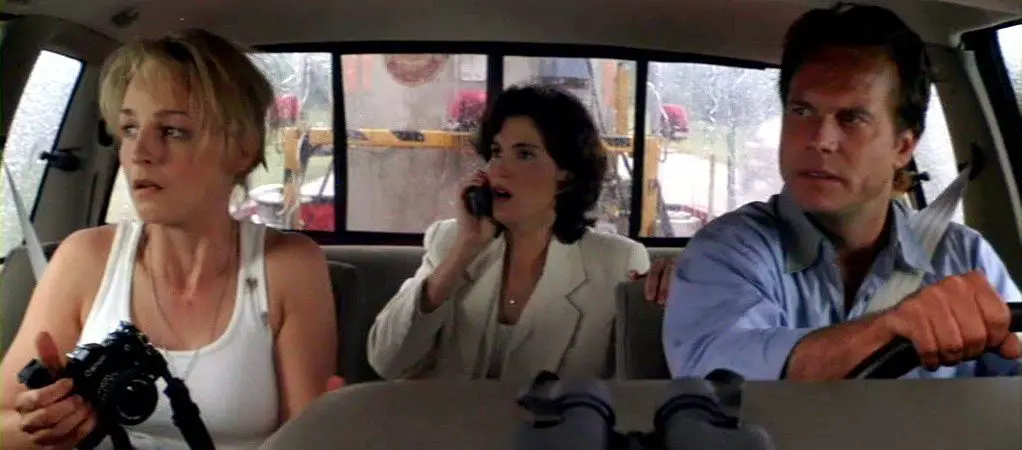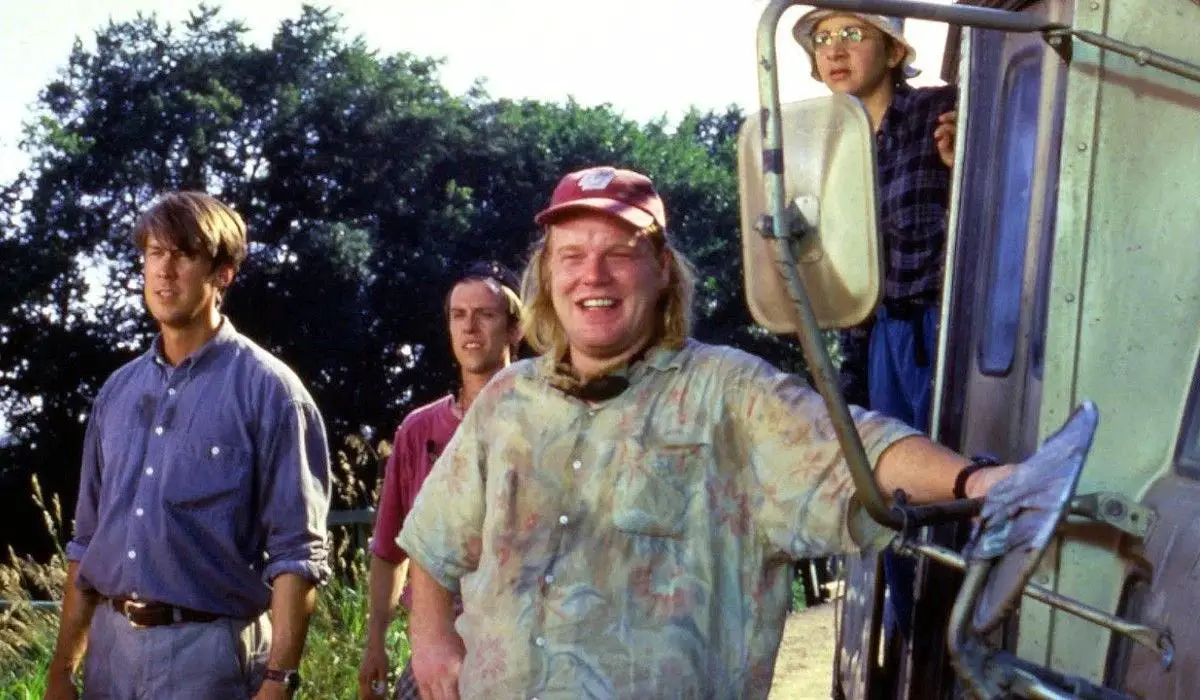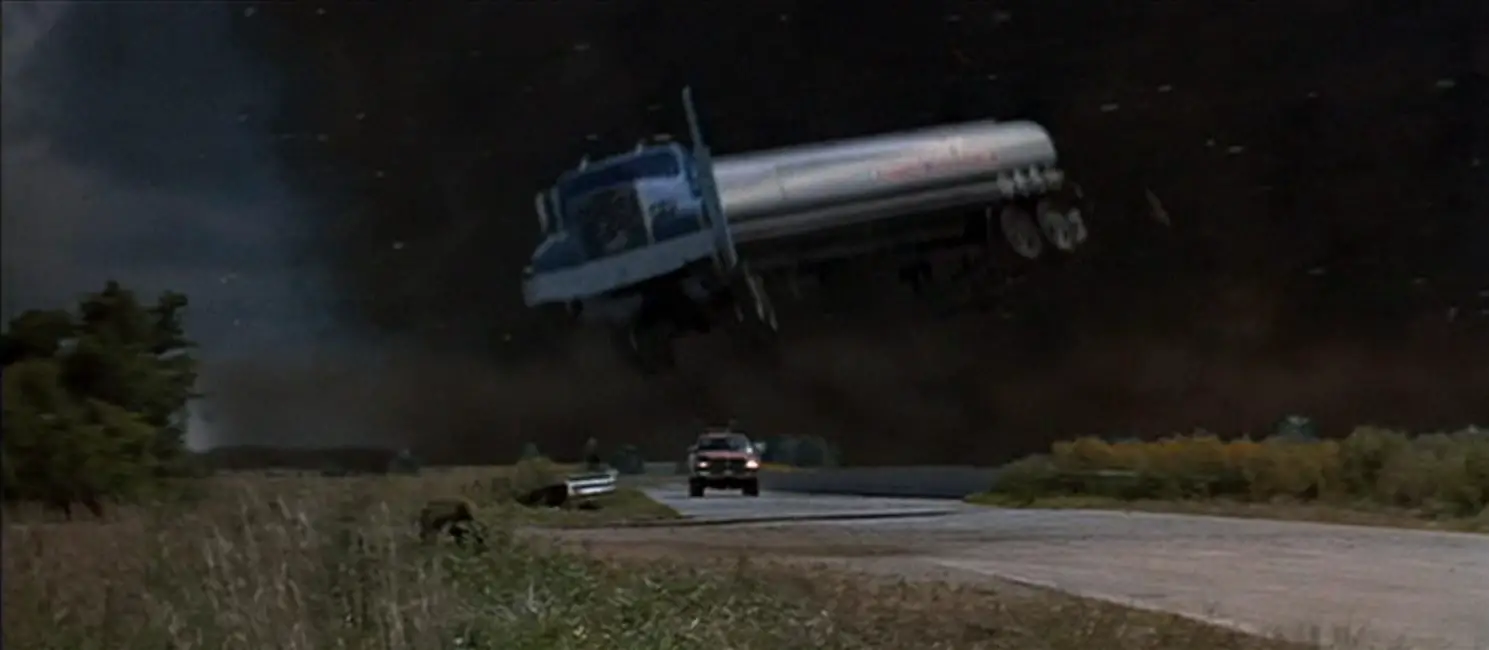I was stunned to see a remarkable maturity in Jan de Bont’s 1996 blockbuster Twister – a movie that is, above all else, big dumb fun on a grand scale. It wasn’t my first time seeing it, but it had been a while. Granted, one could call my decision to watch Twister at the tail end of a hurricane, hours after an earthquake, questionable; I found the movie oddly calming.
Twister is a movie so simple, so straightforward – just some people chasing storms – that it remains one of the most enduring blockbusters of the 90s. Even younger people who haven’t seen “older movies” have seen Twister.

As someone who grew up in Missouri and has encountered his fair share of tornadoes, I found it refreshing how de Bont and his screenwriters, Michael Crichton and Ann-Marie Martin, treated the storms with a kind of reverence. Unlike San Andreas, which treats a natural disaster like a ride at Universal Studios, de Bont, Crichton, and Martin frame the storms with a sense of awe and restrained terror.
Tornadoes are awesome and horrifying things, and despite Twister treating the storms like the shark from Jaws, it’s never done in a cheap, exploitative way.
I don’t want to make it sound like Twister is some profound Hemmingway-esque mediation on the relationship between man and nature or anything. Still, the film is a stark reminder of how little craft seems to reside in modern blockbusters, superhero or otherwise. How de Bont effortlessly jumps from genre to genre, starting with a horror scene of a young Jo (Alexa PenaVega) witnessing an F5 tornado carrying her father away; to a light-hearted rom-com with a now tornado-obsessed Jo (Helen Hunt) coming up with a reason not to sign her divorce papers from her ex and former storm-chasing partner, Bill (Bill Paxton).
The transition is so smooth that it would have been jarring in the lesser hands. But thanks to Crichton and Martin’s script, every character feels lived in, no matter how small. In other words, while the film is stocked to the gills with cliches and tropes, de Bont dispatches them with enough finesse that we hardly notice. Crichton and Martin also make the love triangle between Bill, Jo, and Melissa (Jami Gertz), a reproductive therapist, feels natural. The duo cut out much of the cattiness and senseless jealousies other films might have employed.
This may be why Twister feels mature. The characters are adults, written by adults, and aimed at adults. Even though I saw this film a dozen times when I was sixteen, it somehow never dulled my enjoyment of the film. Funny that.
Also, I’m sorry, “I gotta go, Julia, we’ve got cows!” is a perfect line with sublime delivery from Gertz.
This brings us to the other strength of Twister: its cast. For a disaster flick, the cast comprises some truly heavy hitters, the kind who play every part to its fullest, no matter how small, whether it be Todd Field as Beltzer, Alan Ruck as Rabbit, or Phillip Seymour Hoffman as the stoner himbo Dusty, every part no matter how small, feels like a part of a larger whole.

Even the evil corporate rivals led by the slimy Jonas (Cary Elewes) are stacked with “that guy” actors. The great Abraham Benrubi has no lines, but his familiar visage allows for a sense of fleshing out a team we only get glimpses of. It enables us to write our little stories even as Jonas’s driver Eddie (Zack Grenier), is allowed a few key moments to show us that he might be okay if it weren’t for his boss.
Heck, Lois Smith as Aunt Meg steals the show, and she’s in like two scenes. De Bont allows his actors to exist and, more importantly, lets Jack N. Green’s camera time capture them. For all the kinetic action and near-close calls, de Bont paints a canvas of a group of characters that move and speak like a unit. The glue is Hunt and Paxton’s Jo and Bill trying to overcome their issues, outrun a category F5 and perhaps find their way back to each other.
Green’s camera never lets up but also distracts. De Bont uses Green’s camera to help get from one mood to the next. Take, for instance, how he transitions from the horror of the beginning to the upbeat introduction of Bill, Melissa, and the grown-up Jo. Green’s camera flies over the Oklahoma landscape until we see a truck on the horizon, the camera slowly zooming in on it before cutting inside.
Michael Kahn’s editing is impeccable. Twister has one of my favorite transitions involving Stanley Kubrick’s The Shining at a clever, sly, and unnerving drive-in because it takes a minute to realize what’s happening. Perfect considering the scene precedes one of the more nail-biting sequences.
As Twister draws to a close, the economics of a disaster movie, one damn thing after another, becomes more grandiose. But de Bont directs it all with such confidence, and Crichton and Martin’s script does an excellent job of escalating each encounter that by the time Bill and Jo drive through a house, it feels over the top but not by much.
Have the effects aged well? Yes and no, but if your judgment of a movie rests solely on how well the effects have aged, you’re watching movies wrong. What’s important is not how well the effects have aged but how well they were used. Frankly, even though some scenes look out of a made-for-Syfy movie, de Bont’s direction, Green’s camera, and Kahn’s editing made it the obvious CGI moot.
Movies are a magic trick; if the magician does his job right, you don’t notice how cheap the stage is.

Twister was de Bont’s second film after Speed, another movie that starts breathlessly and rarely stops. A cinematographer turned director, in Twister de Bont shows a keen eye for movement and staging while faithfully fulfilling its duty as a mindless blockbuster with a healthy dose of cheese and nonsense, but with a craftmanship that most blockbusters have, sadly, stopped deploying.
Images courtesy of Warner Bros.
Have strong thoughts about this piece you need to share? Or maybe there’s something else on your mind you’re wanting to talk about with fellow Fandomentals? Head on over to our Community server to join in the conversation!

